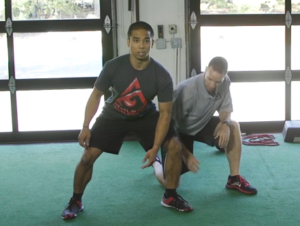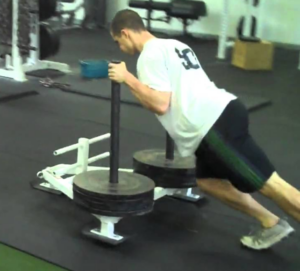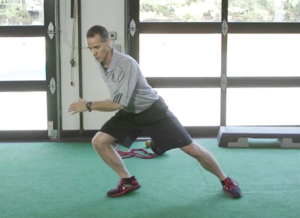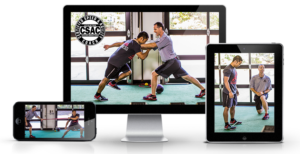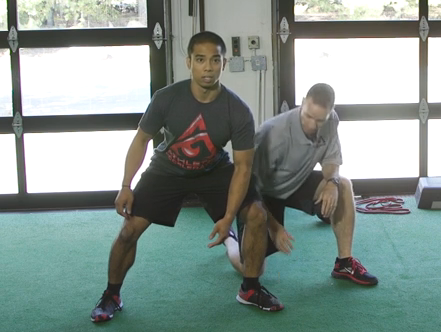
Random Thoughts on Sports Performance Training: Installment 38
I’m going to try to get back on track for one installment of this long-running series each month. This month, it’s a speed/agility theme, as it’s fresh on my mind with this week’s $200 off sale on Lee Taft’s awesome Certified Speed and Agility Coach certification. Let’s get to it.
1. I’m not sure I really like sled sprinting for making most athletes faster.
I’ll probably take some heat for this, but hear me out.
Research has shown that running with sled resistance can help athletes run faster. If you search for “resisted sprinting sled” at Pubmed, you’ll get 63 results – most of which show a beneficial effect. You know what most of them will also show? A bunch of study subjects who really haven’t done a whole lot of strength training. It seems like 2/3 of these studies are in:
a) professional soccer players, who we all know LOOOOOVEEE the weight room (that was sarcasm, for those who aren’t picking it up)
or
b) high school soccer players, who are even weaker than the pro soccer players who hate lifting (and don’t have much training experience)
My feeling is that anytime you take athletes who are either a) really weak or b) hard-wired to the absolute speed end of the continuum (or both) and shift them toward the absolute strength side of things (even if it’s not all the way), you’ll see benefit.
Here’s where things take a twist. In the real world, resisted sled work actually gets integrated in two ways:
a) coaches who don’t have a lot of equipment or an actual facility look for ways to challenge strength a bit more outside at a field. So, it’s a little load for athletes that probably need a lot of load (absolute strength) to thrive.
b) coaches/athletes who are infatuated with lifting heavy stuff and don’t know how to program/coach sprint/agility work very well use sleds as a way to try to convince themselves they’re actually making getting faster a priority. The loads are typically far too heavy to move the weight fast and challenge elastic qualities to a great degree. As such, it’s not enough of a shift to the absolute speed end of the continuum to give them optimal benefit.
If you dig in on the research enough, you’ll see this. This 2020 study demonstrated greater benefits over 8 weeks of training with 40% of body weight as loading than with 80% of body weight (the latter group actually got slower). Another 2020 study of rugby players found that “80% BM [body mass] induced significantly higher hip flexion, lower knee flexion, and higher ankle dorsiflexion than 20% BM condition at 5-10 and 10-20 m distances (p < 0.05). Lighter sled loads (<40% BM) seem to be more adequate to improve speed ability without provoking drastic changes in the unloaded sprinting technique, whereas heavier loads may be more suitable for optimizing horizontal force production and thus, acceleration performance.”
You know who already typically have great acceleration scores? Strong people. They can muscle their way through the first portion of movement and get away with just dabbling in the long (or slow) stretch shortening cycle (>250ms ground contact time) before they get exposed in the short (or fast) stretch-shortening cycle (<250ms ground contact time). Sprinting (and its derivatives) should be short/fast SSC initiatives.
In short, I really don’t think sled work makes people faster if they’re already doing a lot of strength training work. And, I’m not sure I buy that it’s the most efficient way to teach acceleration mechanics. If you’re going to use it in conjunction with a comprehensive strength training program, make sure the load of the sled is really light.
And, if you’re planning to load it up more, it’ll probably work best in scenarios of naturally elastic athletes who don’t have a huge foundation of strength. It’s probably good for limited equipment scenarios, but be cautious of how much you integrate because it may actually negative impact sprinting mechanics.
Now, feel free to argue on Twitter if you want to disagree with me.
2. Just coaching a directional step doesn’t necessarily improve speed; you have to coach the other leg, too.
In a 2017 study, Tomohisa et al. found that the jab step (also known as the directional step) is superior for base stealing. No surprise there; it’s what the overwhelming majority of successful baserunners do at the pro and college levels. However, what I think this study did do a great job of is discussing why the jab step is superior to the crossover step, thanks to both a motion capture system and two force platforms:
“The results showed that the normalised average forward external power, the average forward-backward force exerted by the left leg, and the forward velocities of the whole body centre of gravity generated by both legs and the left leg were significantly higher for the JS start than for the CS start. Moreover, the positive work done by hip extension during the left leg push-off was two-times greater for the JS start than the CS start.”
Boiled down to simpler terms, while the right leg gets a ton of attention for it setting up acceleration via a) creating a positive shin and b) mechanically repositioning the center of mass outside the base of support, the truth is that we should be talking about how the left leg is doing the lion’s share of the work. Doubling your hip extension is a HUGE deal, as you’re gaining ground without having to reach with the front leg (which could set you up for negative shin angles on subsequent steps).
That said, it still has to be coached; just coaching the right leg doesn’t get the job done. You have to teach them to feel the left leg push-off. I like telling the athlete to “push the ground away” on the trailing leg, and have also seen some benefit by standing between 1st and 2nd base and having the athlete isometrically against me to get a feel for what the back hip/leg should be doing.
3. Playing multiple sports is great not only for exposure to a wide variety of movement patterns, but also because of the high volume of variable plyometric activity involved.
Playing multiple sports builds better long-term athletes in large part because they’re exposed to rich proprioceptive environments that enable them to develop motor strategies for dealing with any challenge sports or life may throw at them. If you build a big foundation of general athletic proficiency, you’re more likely to be successful when the time comes to stack specific athletic proficiencies on top of that base. However, there’s likely another benefit: volume.
I recall reading years ago that the average midfielder makes 2,200 changes of direction in a soccer match. That’s a ton of work – and no two cuts are like one another. I’m sure you can find similar crazy statistics with basketball, tennis, football, and a host of other activities. It’s so hard to find that “varied” volume in any other way – and it’s particularly advantageous that many of these activities take place during childhood growth spurts, when it’s super advantageous to train power (great stuff from Dr. Greg Rose on this in this previous podcast), because long bone growth has outpaced the ability of muscles/tendons to keep up. As such, you get springy athletes!
I’ve often said that it’s easier to make a fast guy strong than it is to make a strong guy fast. One reason for this is that it’s not hard to build strength with a limited volume of work in the weight room. However, it’s incredibly hard to build elasticity without a ton of reps. And, if I get a baseball-only kid at age 16 who hasn’t played multiple sports, I’ve got an uphill battle to chase elasticity – both of the tendons and fascial system – without hurting him.
So, take my word for it: early specialization is a bad idea – and we’re discovering more and more reasons why that’s the case with each passing day.
One Final Note: If you’re looking to learn more about Lee’s approach to programming and coaching speed and agility work, I highly recommend his Certified Speed and Agility Coach course. The information is top notch, and it’s on sale for $200 off through Sunday. This resource is mandatory viewing for all our staff members, and it was actually filmed at Cressey Sports Performance – MA. You can learn more HERE.

